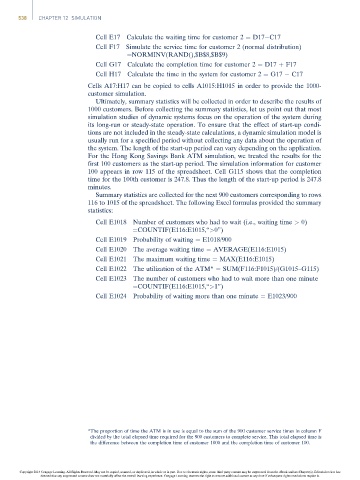Page 558 -
P. 558
538 CHAPTER 12 SIMULATION
Cell E17 Calculate the waiting time for customer 2 ¼ D17 C17
Cell F17 Simulate the service time for customer 2 (normal distribution)
¼NORMINV(RAND(),$B$8,$B$9)
Cell G17 Calculate the completion time for customer 2 ¼ D17 þ F17
Cell H17 Calculate the time in the system for customer 2 ¼ G17 C17
Cells A17:H17 can be copied to cells A1015:H1015 in order to provide the 1000-
customer simulation.
Ultimately, summary statistics will be collected in order to describe the results of
1000 customers. Before collecting the summary statistics, let us point out that most
simulation studies of dynamic systems focus on the operation of the system during
its long-run or steady-state operation. To ensure that the effect of start-up condi-
tions are not included in the steady-state calculations, a dynamic simulation model is
usually run for a specified period without collecting any data about the operation of
the system. The length of the start-up period can vary depending on the application.
For the Hong Kong Savings Bank ATM simulation, we treated the results for the
first 100 customers as the start-up period. The simulation information for customer
100 appears in row 115 of the spreadsheet. Cell G115 shows that the completion
time for the 100th customer is 247.8. Thus the length of the start-up period is 247.8
minutes.
Summary statistics are collected for the next 900 customers corresponding to rows
116 to 1015 of the spreadsheet. The following Excel formulas provided the summary
statistics:
Cell E1018 Number of customers who had to wait (i.e., waiting time > 0)
¼COUNTIF(E116:E1015,‘‘>0’’)
Cell E1019 Probability of waiting ¼ E1018/900
Cell E1020 The average waiting time ¼ AVERAGE(E116:E1015)
Cell E1021 The maximum waiting time ¼ MAX(E116:E1015)
Cell E1022 The utilization of the ATM* ¼ SUM(F116:F1015)/(G1015–G115)
Cell E1023 The number of customers who had to wait more than one minute
¼COUNTIF(E116:E1015,‘‘>1’’)
Cell E1024 Probability of waiting more than one minute ¼ E1023/900
*The proportion of time the ATM is in use is equal to the sum of the 900 customer service times in column F
divided by the total elapsed time required for the 900 customers to complete service. This total elapsed time is
the difference between the completion time of customer 1000 and the completion time of customer 100.
Copyright 2014 Cengage Learning. All Rights Reserved. May not be copied, scanned, or duplicated, in whole or in part. Due to electronic rights, some third party content may be suppressed from the eBook and/or eChapter(s). Editorial review has
deemed that any suppressed content does not materially affect the overall learning experience. Cengage Learning reserves the right to remove additional content at any time if subsequent rights restrictions require it.

